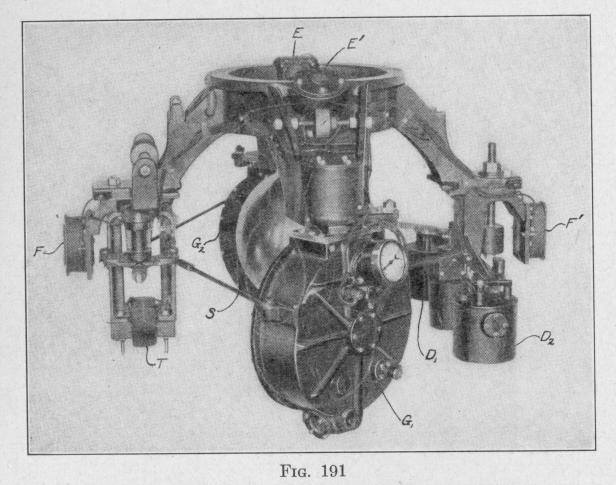236 NAVIGATIONAL COMPASSES
The terminals of the amplifying circuit and the line Z, Fig. 189, are joined to the terminals of a three-phase reversing motor M, Fig. 178.* By these means, the hollow sphere is turned till the followup electrodes are in the equilibrium position, that is, till the northsouth line of the compass card is in the geographic meridian. The same lines operate repeater compasses, a course recorder, an automatic pilot, or other repeater devices.
§6. The Arma Gyro-Compass
142. The Sensitive Element. - The Mark IV Model 1 gyrocompass made by the Arma Engineering Company of Brooklyn, New York, Fig. 190, has two gyros capable of precession about
vertical axe's. The two gyro-casings are held by a bell crank and springs so that the angle between the spin-axles is kept constant, Fig. 191. When the sensitive element is in the resting position, the spin-axles are inclined about 40 degrees from the meridian.
The gyros spin at about 12,000 revolutions per minute in an atmosphere of helium under low pressure. The advantages in the use of helium are the same as in the use of hydrogen (Art. 135).
* U. S. Patent. Anschutz, No. 1586233, 1926. " The New Anschutz,"
published by the Nederlandsche Technische Handel Maatschappy "Giro," The Hague, Holland.
THE ARMA GYRO-COMPASS 237
The frame that supports the gyro-casings also carries two connected oil tanks, D1, D2, Fig. 191. One of these tanks is on the north and the other is on the south side of the frame when the element is in the resting position. The motion of oil back and forth from one tank to the other quickly damps vibration of the sensitive element (Art. 137).
Figure 192 represents the two principal units of the master enmnass nulled apart vertically. The gyros and attachments are
supported by a hollow metal globe, S, that floats in a bowl of mercury, H. The globe together with the two gyros G, and G2, with the entire supported system, constitute the sensitive element. Any change in friction that might be produced by variations in the surface tension at the line of contact of mercury, air and metal is prevented by a continuous vibration of the mercury maintained by a small motor fastened to the bowl and to the binnacle.
The compass card A, a horizontal gear and horizontal arm PP' are fastened rigidly to a vertical tubular shaft R. This system constitutes the phantom element. The phantom is carried by the compass frame. The latter is hung by springs from the inner gimbal rings of the binnacle. The phantom element is capable of being rotated about a vertical axis by a follow-up motor M. The

